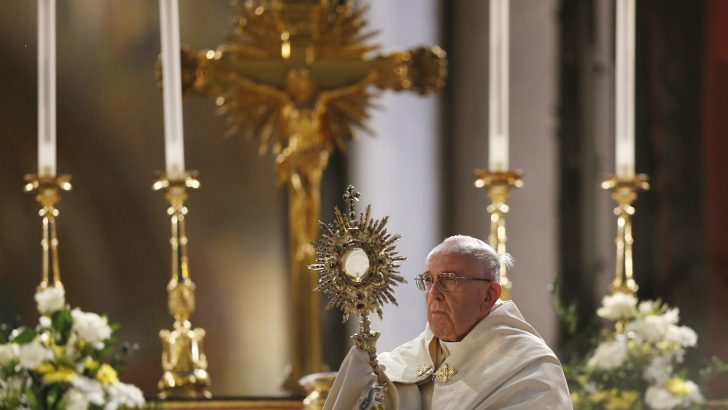Notebook
For some Irish Catholics, it’s hard to think of Corpus Christi, the feast we celebrate this weekend, without getting nostalgic about the beauty of past celebrations, and even becoming resentful about the almost total absence of Eucharistic processions in the life of the Church today.
I never experienced Corpus Christi processions when I was growing up.
For me Eucharistic worship was always associated with the relative privacy of Church buildings, rather than the public spaces of towns and villages, where all eyes could see and all knees bend.
But from its foundation, until recently, the feast of Corpus Christi, at least in Catholic countries, did indeed have this public, corporate character. It was an opportunity to express a key point of Eucharistic doctrine: the Eucharist unites people. You might not like your neighbour, this neighbourhood might dislike that neighbourhood, but on Corpus Christi, all rivals might find a deeper unity in Christ.
Right from the beginning the link between Eucharist and unity was clear to the Church. Apart from St Paul’s powerful teaching in 1 Corinthians, we have the evidence too of the oldest surviving Eucharistic prayer, from a 1st-Century document called the Didache. There we find the celebrant praying over the bread on the altar, about to become the Body of Christ: “Even as this broken bread was scattered over the hills [i.e. as wheat], and was gathered together and became one, so let your Church be gathered together from the ends of the earth into your Kingdom.”
It is at such a time that we need to devote ourselves wholeheartedly to peace and harmony within the Church”
And when St Ignatius of Antioch was being brought to Rome in chains early in the second century, his constant insistence in the letters he wrote to various Churches was that their Eucharistic celebrations be expressions of unity: “Take heed, then, to have but one Eucharist. For there is one flesh of our Lord Jesus Christ, and one cup to [show forth] the unity of his blood; one altar; as there is one bishop, along with the presbyters and deacons.”
In 21st-Century Ireland, we can no longer express Eucharistic unity by means of dramatic public processions, for the reason that a great many of our neighbours simply are not one with us in faith. But it is crucial that we don’t allow our disappointment at post-Catholic Ireland to lead us to snipe at each other, to snipe at our priests and bishops, and to stir up disunity in the community of believers.
We may be smaller, our celebrations may be more private, but it is precisely at such a time that we need to devote ourselves wholeheartedly to peace and harmony within the Church, in everything we do and say.
Loving the Eucharist means loving unity.
Well that’s one way of making your point!
One of the ways we visibly express the peace that comes to us from the altar is by offering to one another the sign of peace. We don’t know when this sign will be restored to the liturgy, but it’s worth noting that there was a slightly different way of expressing this peace in the Middle Ages.
Typically, it involved the priest and congregation, one by one, kissing a round object called a pax, made of metal or ivory. As historian Eamon Duffy explains in his Stripping of the Altars, the pax was often presented to people on the basis of social rank, which could sometimes cause tensions.
One Sunday in an Essex parish in 1522, a certain John Browne declared himself worthy of being given the pax first, and threatened the sacristan with violence if he wasn’t awarded this honour the following week.
Next Sunday he was still No.2 so, after devoutly kissing the pax he – rather less devoutly – broke the pax over the sacristan’s head. Not exactly the spirit of Eucharistic unity…


 Pope Francis leads Benediction outside the Basilica of St. Mary Major on the feast of Corpus Christi in Rome in 2016.
Pope Francis leads Benediction outside the Basilica of St. Mary Major on the feast of Corpus Christi in Rome in 2016. 